The Most Optimistic Star Trek Episodes
We look to a hopeful future with these great episodes across the Star Trek franchise.

In the Star Trek: The Next Generation season 1 episode “The Neutral Zone,” Captain Jean-Luc Picard speaks with an angry capitalist who was cryogenically frozen in 1994 and reanimated aboard the Enterprise-D. When the capitalist tries to resume his wheeling, dealing ways, Picard sets him straight.
“A lot has changed in the past three hundred years,” Picard explains. “People are no longer obsessed with the accumulation of things. We’ve eliminated hunger, want, the need for possessions. We’ve grown out of our infancy.”
That idea of humanity growing out of its infancy remains one of the most compelling aspects of the Star Trek franchise. For the original series, creator Gene Roddenberry imagined a future beyond racism and sexism, a utopia in which humanity worked together to travel the stars. Even if they sometimes took darker turns, every Star Trek series has followed, showing us what we could be.
That future has never seen more fantastic than it does today, so let’s take a moment to find some hope in some of Star Trek‘s most optimistic episodes.
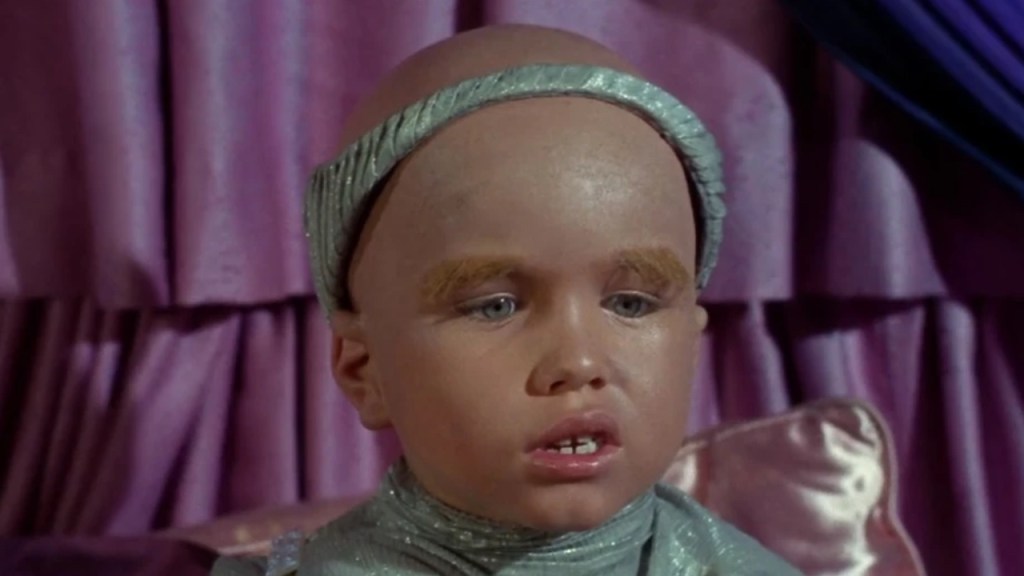
The Corbomite Maneuver (TOS)
Season 1 Episode 10
In the popular imagination, “The Corbomite Maneuver” exists as a cheesy TOS episode with a ridiculous-looking infant and baby Clint Howard, looking even more ridiculous, especially over-dubbed with a man’s voice. “The Corbomite Maneuver,” in which a powerful alien ship threatens the Enterprise with destruction, is certainly all of those things. But it’s also a testament to the franchise’s hopeful spirit.
When faced with the strange creature, Kirk delivers a speech that captures everything great about Star Trek. “You know the greatest danger facing us is ourselves, an irrational fear of the unknown. But there’s no such thing as the unknown– only things temporarily hidden, temporarily not understood.” Time and again, Star Trek would feature heroes who work to discover those things. And sometimes discover that all we feared was just Clint Howard all along.

Balance of Terror (TOS)
Season 1 Episode 14
It’s one thing to talk about an irrational fear of the unknown when facing down a weird puppet. It’s another thing when dealing with the potential for intergalactic war. And yet, Kirk shows the same ability to keep his cool in “Balance of Terror,” in which the Enterprise encounters a ship from the Romulan Star Empire, marking the race’s first appearance in the franchise.
“Balance of Terror” is perhaps the single greatest example of Kirk’s acumen as captain. As he faces off with a Romulan Commander (Mark Lenard, who would later portray Spock’s father Sarek), fully aware that any action could spark an intergalactic war, Kirk must also contend with mistrust within his crew, especially after learning that Romulans resemble Vullcans. From his quick rejoinder to a racist crewman to his deliberate conversations with the Romulan Commander, “Balance of Terror” imagines leaders at their wisest and most competent.
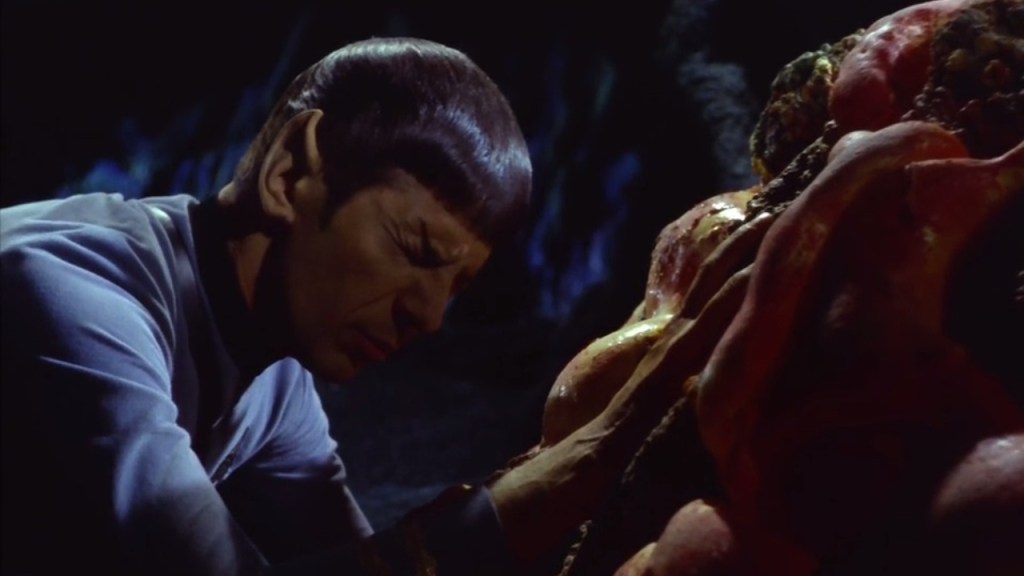
The Devil in the Dark (TOS)
Season 1 Episode 25
Both “The Corbomite Maneuver” and “Balance of Terror” present reason over fear as a heroic choice. “The Devil in the Dark” makes empathy heroic. “The Devil in the Dark” starts with what has already become a standard Star Trek premise, in which Kirk and company encounter something familiar. In this case, Enterprise must investigate a creature killing miners and, one assumes, must kill the beast.
Where the two previously mentioned TOS episodes put Kirk in the spotlight, “The Devil in the Dark” focuses on Spock. That might seem counterintuitive, given the Vulcan’s position in the show as the voice of emotionless reason. However, Spock’s ability to mind-meld, used here for the first time in the franchise, allows him to understand the creature’s plight, that she’s a mother whose children are being killed by the miners’ actions. From that understanding, Spock and Kirk solve the problem, putting empathy and care for even nonhumanoid lifeforms first.

The Drumhead (TNG)
Season 4 Episode 21
With “The Drumhead,” Picard gets his own version of “Balance of Terror.” Once again, we have an Enterprise captain dealing with the threat of the Romulan Star Empire. And once again, it’s up to the Captain to pursaude everyone to keep their cool. In this case, Starfleet suspects sabotage after an explosion in engineering and sends noted mole hunter Admiral Satie (Jean Simmons) to uncover the leak. Satie thinks that she’s found it when she learns that Ensign Simon Tarses (Spencer Garrett) has Romulan DNA.
Although Satie’s convinced of Tarses’s guilt, Picard slows the accusations. With perhaps the exception of “The Measure of a Man,” “The Drumhead” features Picard in his best Atticus Finch mode. His powerfully articulates the importance of assuming innocence without sufficient proof and outlines the slippery slope that follows a rush to war. “The Drumhead” shows that everything isn’t perfect within Trek‘s utopian future—heck, almost every admiral in the franchise is bad—but there will always be good people who stand up to those in power.
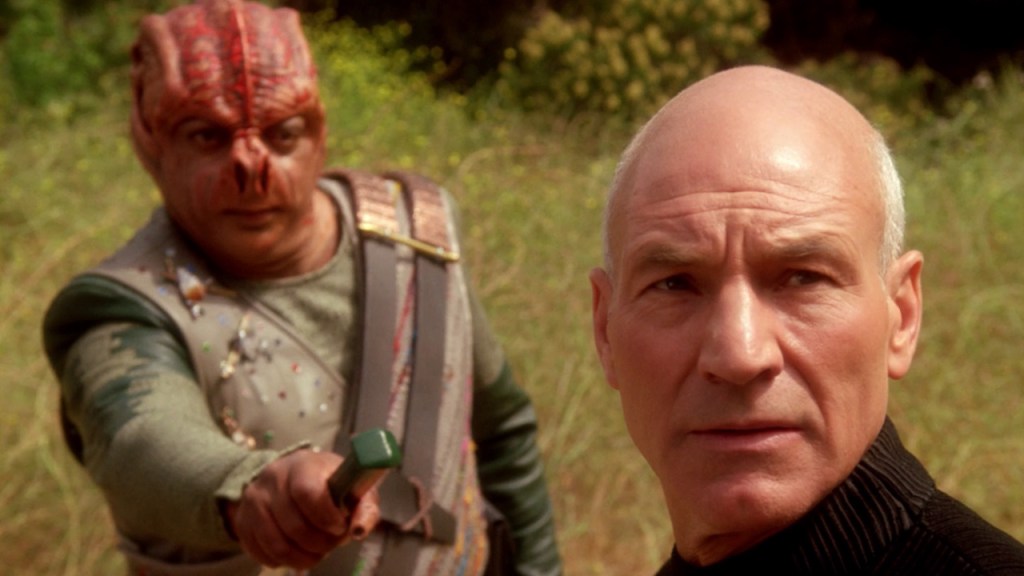
Darmok (TNG)
Season 5 Episode 2
Picard’s ability to communicate, making full use of Patrick Stewart’s stentorian voice, is easily his greatest asset. So what happens when that voice doesn’t matter? That’s the quandary he faces in “Darmok,” in which Picard gets stranded an alien planet with a Tamarian, whose metaphor-based language renders the two incomprehensible to one another.
Much of the joy in “Darmok” comes from watching how Picard and the Tamarian Captain Dathon (Paul Winfield, who also played the doomed captain of the Reliant in Star Trek II: The Wrath of Khan) gripe about their failed connections, complete with the latter’s memorable phrases: “Darmok and Jalad at Tanagra” and “Shaka, when the walls fell.” But the hope comes in the fact that they do in fact find a way to communicate, showing us that two people from extremely different backgrounds can understand one another.
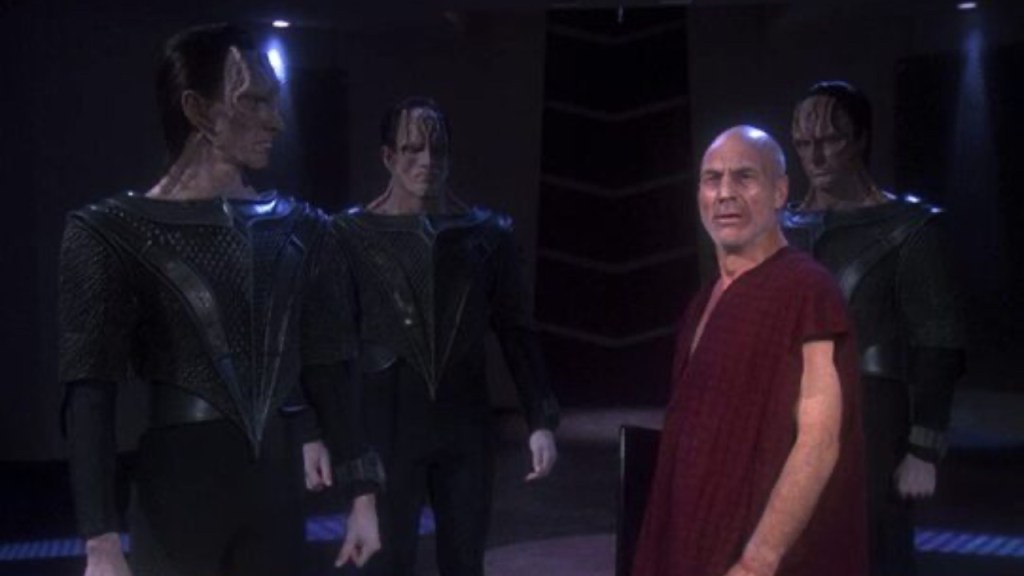
Chain of Command (TNG)
Season 6 Episodes 10 and 11
“Chain of Command” is, of course, one of the best two-parters in Trek history, for several reasons. It introduces Captain Jellico (’80s “That Guy” Ronny Cox), who gets to be both the exact opposite of Picard and incredibly competent. It gives an in-universe reason for Riker’s continuing to avoid promotion to captain, despite his excellent service record. And it finally gives Troi the proper Starfleet uniform she deserves. But the best part, of course, is the mental face between Picard and his captor, Cardassian Gul Madred, played by the great David Warner.
Madred’s form of torture is insidious in its simplicity. Madred shows Picard four lights and asks him how many he sees. When Picard answers correctly, Madred says he’s wrong, that there are five lights, and shocks the Captain. Yet, no matter how hard Madred fights to steal Picard’s mind and confidence, the Captain refuses to yield. As he demonstrates in one of his best, most underrated monologues, Madred—like countless other real-world people in power—might have the tools and the means to enforce their version of the truth. But in the end, they’re just bullies, and bullies are fundamentally weak.
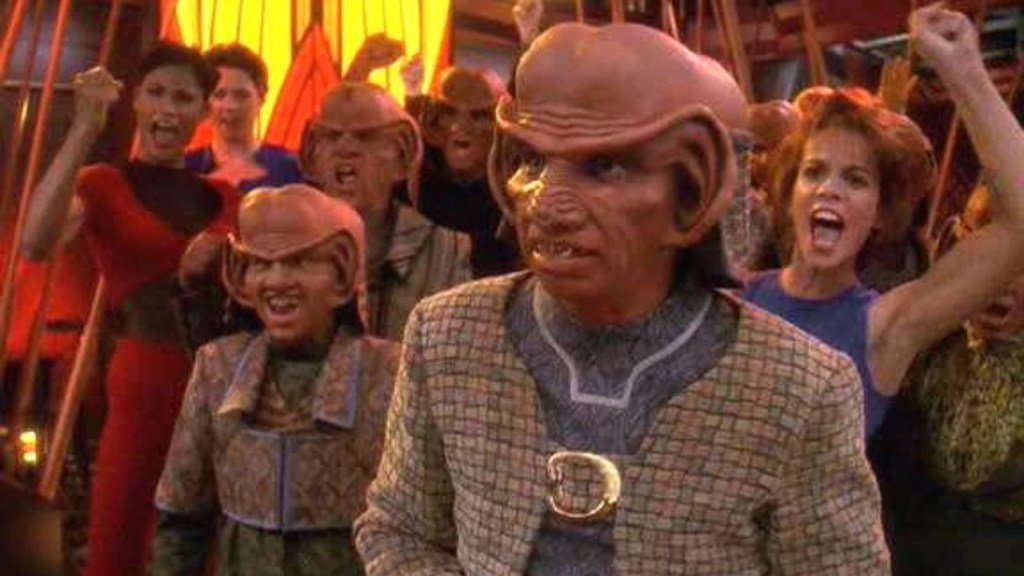
Bar Association (DS9)
Season 4 Episode 16
In most cases, Star Trek addresses real world threats via allegory. Not so with “Bar Association,” in which Rom must deal with one of the greatest threats in the world today: a greedy boss who wants to exploit his workers. In this case, the boss is Rom’s brother Quark, who runs his bar according to the hyper-capitalist Rules of Acquisition that drive his people. Inspired by Miles O’Brien’s ancestor—”He was more than a hero; he was a union man”—Rom organizes his co-workers to strike against Quark.
Like most Ferengi-focused episodes of Deep Space Nine, “Bar Association” has plenty of comedy to lighten the mood. And, to be sure, Quark’s unfair labor practices don’t fill the viewer with dread like the Jem’Hadar. But while few of us viewers will ever have to do battle with warriors pumped up on ketracel-white, most of us will have to stand up to those who would exploit us, making Rom’s rebellion one of the most immediately hopeful moments in the entire franchise.

In the Cards (DS9)
Season 5 Episode 25
With the exception of maybe the first two seasons of Star Trek: Picard and (ugh) the Section 31 movie, Deep Space Nine is easily the series most skeptical of Federation ideals. As they face the annihilating force of the Dominion, Sisko and his crew make some morally questionable decisions (to their credit, though, they do actually debate and question those decisions, something missing from more recent attempts to darken the franchise).
And yet, the series never forgets the humanity at the center of the war, a point illustrated by the extremely low-stakes episode, “In the Cards.” It may occur on the cusp of the Dominion War, but instead of taking us back to the front lines, it follows Jake and Nog as they try to get a rare baseball card to give as a gift to Sisko. As we’ll talk about next, Jake and especially Nog will be forever changed by the Dominion War, so there’s something wonderful about seeing kids being kids, doing something silly and sweet without (yet) being tainted by war.
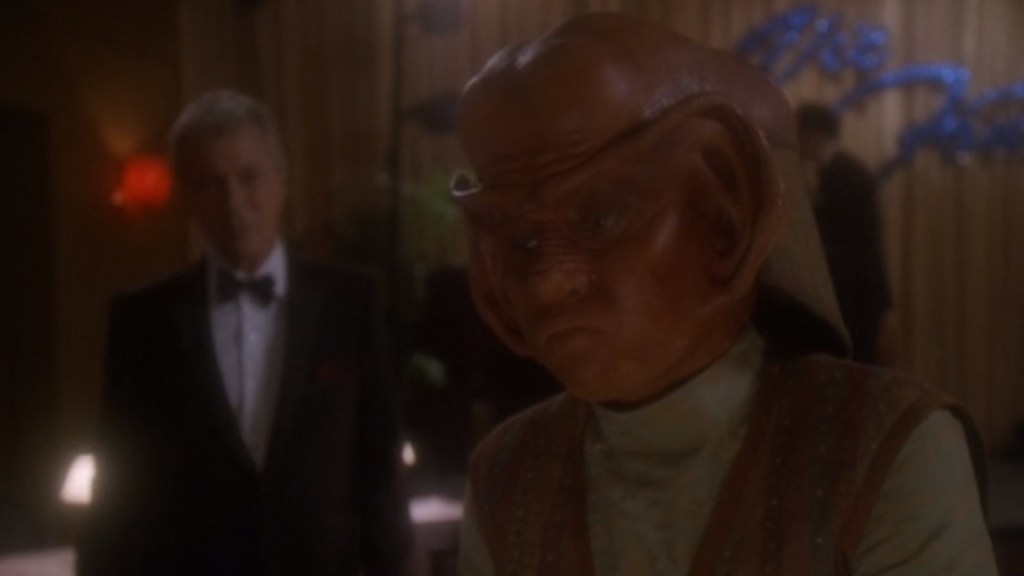
It’s Only a Paper Moon (DS9)
Season 7 Episode 10
On first glance, it’s hard to see how “It’s Only a Paper Moon” fits on a list of most hopeful Star Trek episodes, especially coming after “In the Cards.” After all, “It’s Only a Paper Moon” finds Nog crippled and traumatized from the Dominion War, having lost his leg in battle. One of the series’ most inspiring moments came when Nog joined Starfleet; this episode sees Nog at his lowest point.
Nog’s only comfort comes from listening to the song “I’ll Be Seeing You,” as performed by hologram Vic Fontaine, and that desire for comfort drives him to live in Vic’s lounge and pad in a holosuite. But when Vic, Jake, and counselor Ezri Dax realize that Nog’s delaying his healing by escaping into a safe fantasy, they must work to help him face the difficult truth. Nog’s journey, brilliantly depicted by the late Aron Eisenberg, is a difficult one and isn’t always pretty. But the mere fact that he finds healing earns the episode’s place on this list.
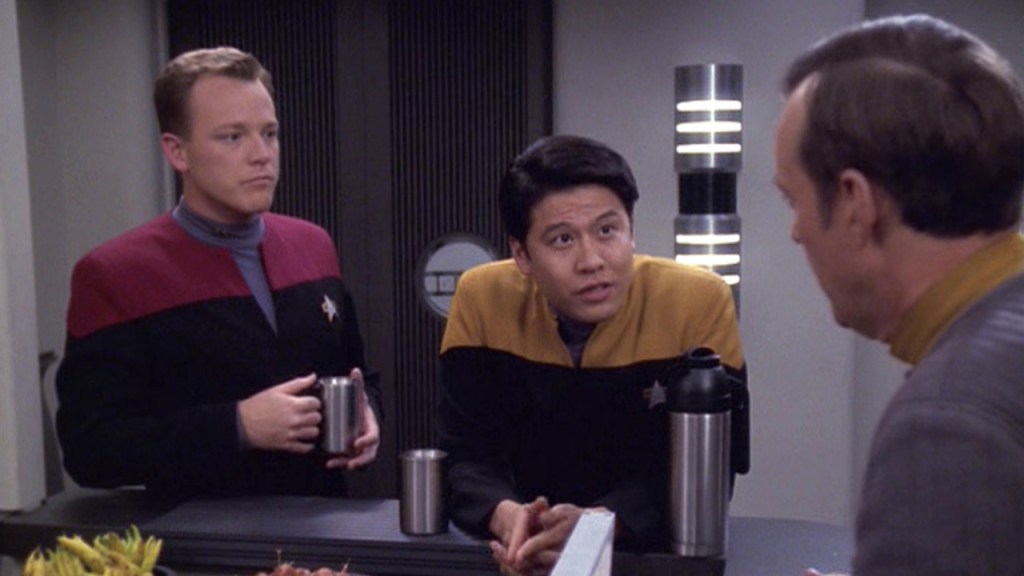
Pathfinder (VOY)
Season 6 Episode 1
“Pathfinder” belongs on this list because it offers hope in two different ways. First, the episode features the first real reconnection between Starfleet and the long-lost Voyager, setting up the ship’s return to the Alpha Quadrant in the series finale at the end of season seven. Second, that reconnection happens via Reginald Barclay, the hapless engineer first introduced in TNG.
“Pathfinder” takes its time getting to the happy stuff. Most of the episode follows Barclay, who seems to be distracting himself with holographic versions of the Voyager crew, suggesting a regression from his growth in TNG. But Barclay’s holographic discursions prove to be instrumental for uncovering a way to contact Voyager in the Delta Quadrant. By the end of the episode, not only has Admiral Paris of Starfleet been able to send a message to Voyager (and to his son Tom), but the real Voyager crew has developed real respect for Barclay, making his fantasies come true.
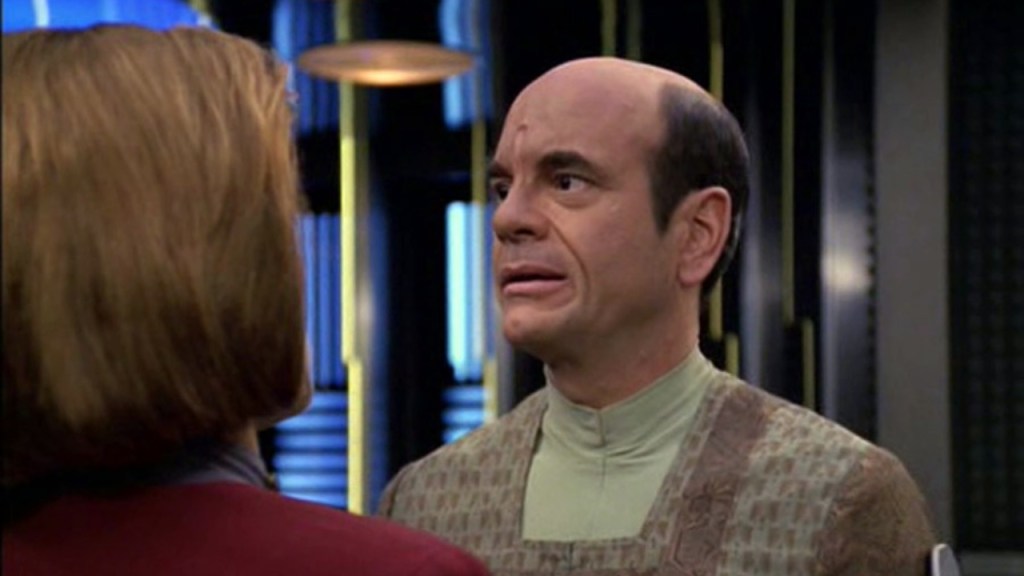
Blink of an Eye (VOY)
Season 6 Episode 12
Readers of Den of Geek certainly need no introduction to “Blink of an Eye,” as it regularly lands on lists of the best Star Trek and Voyager episodes. In most cases, the episode’s use of a high sci-fi concept gets the praise. But “Blink of an Eye” also deserves praise for its depiction of a society coming out of its primitive superstitions and into an age of wonder.
In “Blink of an Eye,” Voyager gets caught in an unusual tachyon field surrounding a planet, which means that time passes on the planet at a rate of 58 days to every minute on the ship. As the Doctor regularly visits the planet to investigate a way to free the ship, he witnesses not only the march of civilization, but the people’s attachment to the sky-bound Voyager as a type of deity. As the civilization develops, they grow more rational and knowledgable and, crucially, more compassionate. By the end of the episode, we’ve seen in miniature the promise inherent in every Star Trek story, that progress will eventually succeed and people will be better for it.
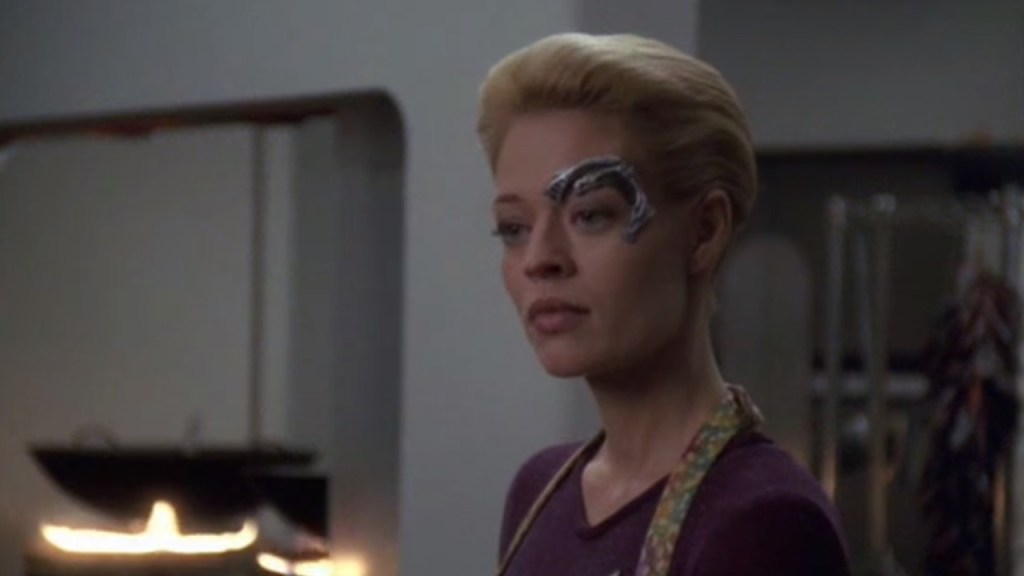
The Void (Voy)
Season 7 Episode 14
Even more than the much-ballyhooed “Year of Hell,” “The Void” feels like Star Trek: Voyager in miniature. The episode finds the ship sucked into an empty space, stranded with other various vessels, all of whom fight one another to survive. Instead of fighting, Janeway decides to not only follow the Federation charter, but to build a new Federation, urging cooperation instead of competition.
Despite its ultimately affirming conclusion, “The Void” isn’t all sunshine and optimism. As is her wont, Janeway makes some hard decisions that irritate her crew, especially when she refuses to use equipment that would help the ship survive because their ally obtained it through unethical means. But that difficulty only gives some necessary grit to the episode’s hopefulness, an insistence that fear and desperation do not give us the right to indulge our worst selves.
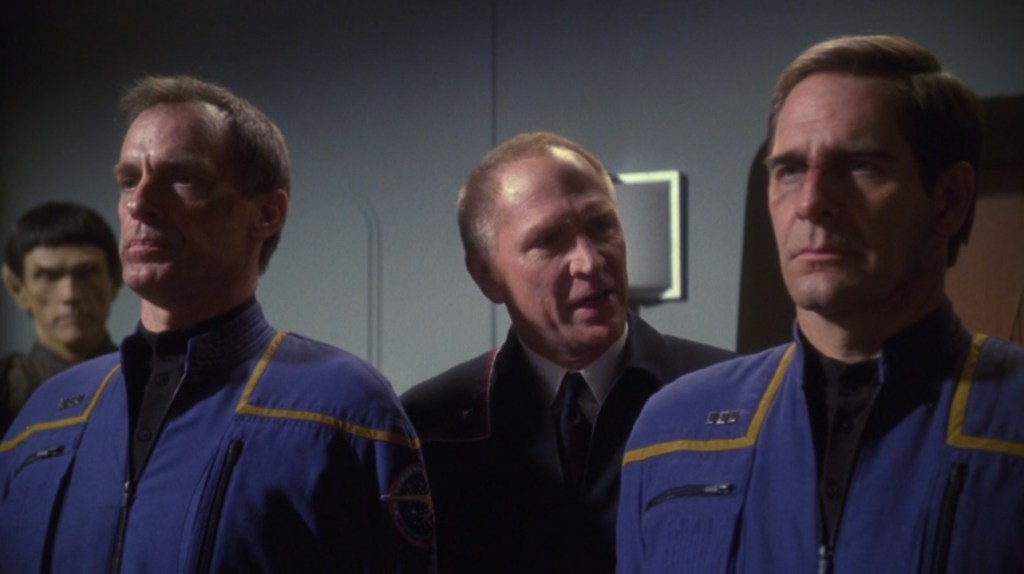
First Flight (ENT)
Season 2 Episode 24
Like DS9, Enterprise was rarely a show that felt optimistic. After two rambling seasons, the series finds its footing for its final two seasons, but it does so through a 9/11 allegory based around the Xindi War. In these seasons, Starfleet abandons its exploration and scientific mandate to become explicitly militaristic and, unlike DS9, it does so with very little debate. However, even within that lens, there’s still hope to be found in Enterprise, as demonstrated by the season two flashback episode “First Flight.”
“First Flight” recounts the story of Archer becoming Captain of Enterprise, a job that initially seemed destined for his rival Commander Robinson (Keith Carradine). For most of the episode, Robinson seems like the much better choice to lead the project, as Archer is belligerent and reckless (as always). However, the two find common ground when a design by Archer’s late father becomes the missing piece of the NX project, and Robinson concedes the seat to Archer. “First Flight” has more in common with the film The Right Stuff than it does classic Star Trek, but we see in it flashes of the brave explorers that humanity will later become.

Demons (ENT)
Season 4 Episode 20
As a prequel series, Enterprise was always building up to the point where the United Federation of Planets came into being. But for most of the series’ four seasons, it seemed like the organization would never come to be. Not only did Archer spend most of the series with a huge chip on his shoulder to the Vulcans and not only did the Vulcans earn that resentment, but the Tellarites and Andorians didn’t seem to care for anyone else, either. At the center of it all was Captain Archer, perhaps the least diplomatic captain in Star Trek history.
And yet, the Federation arrived nonetheless, with the crucial issues addressed in “Demons.” “Demons” sends Archer and company to Earth for a conference that will lead to the founding of the Federation, and shows the various forces that threaten to destroy it before it begins, including xenophobic mining magnate John Frederick Paxton (Peter Weller, who later play another warmongering human in Star Trek Into Darkness). It’s clear that the truncated ending of Enterprise after four seasons meant that they never got to do the full exploration that they wanted. But that only underscores the themes, showing that despite our intentions and despite external difficulties, we can still make connections.
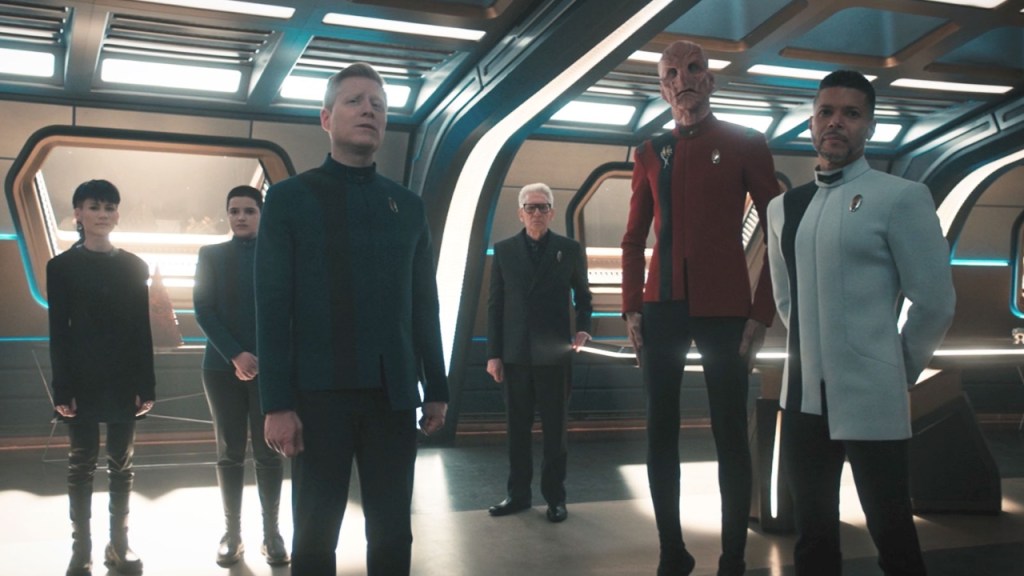
“… But to Connect” (DISCO)
Season 4 Episode 7
Star Trek: Discovery wanted so badly to be inspirational, and so often failed to do so. Too frequently, writers took shortcuts in character-building, trying to yank tears from viewers instead of earning them (see the treatment of Arium in “Project Daedalus”). “…But to Connect” offers the rare and welcome exception to the rule, a restatement of franchise values that came through debate.
“…But to Connect” plays like a riff on TNG‘s “The Measure of a Man,” as members of Discovery‘s crew must decide the fate of Zora, the AI who becomes the ship’s benevolent computer after being corrupted by Section 31’s Control in season 2. Part of the debate involves testimony from characters like Stamets, who was nearly killed by Control and who has legitimately gripes with Zora. By including testimony from Stamets and by acknowledging the threats Zora still could pose, “…But to Connect” gives weight to its decision to keep her as ship’s computer, allowing the series to (briefly) become as moving as it longed to be.

Envoys (Lower Decks)
Season 1 Episode 2
Although it would become a rich, compelling series in its own right, Lower Decks‘s first seasons were more concerned with in-jokes than proper stories. However, one of those jokes revealed the aspirational core of Star Trek, in which individual desires were honored in the most mundane ways. In the B-plot of “Envoys,” Ensign Rutherford begins to doubt that engineering is the path for him and decides to explore other options. Each time he goes to his commanding officer to propose a switch, the officer initially seems annoyed at Rutherford’s lack of commitment, only to reveal that they’re happy for him and encourage him to find the right fit.
It’s not the most complex gag, but that’s the point. In a future without wage labor, people have the right to find an occupation that best suits them. Moreover, people are actually happy to help one another find that occupation, instead of getting bitter because they’re overworked and underpaid and filled with stress. Think that the reaction to Rutherford is too mundane to be optimistic? Then you clearly haven’t worked a retail job.

Ad Astra per Aspera (SNW)
Season 2 Episode 2
Whatever one feels about nü-Trek, no one can deny that recent series tend to avoid the high-minded monologues that Kirk and Picard used to give on a weekly basis. That’s part of what makes “Ad Astra per Aspera,” the second episode of the second season of Strange New Worlds, so special. Most of the episode feels like a courtroom drama, in which Starfleet brings a court martial suit against Enterprise first officer Una Chin-Riley for failing disclose her augments, something banned by the Federation.
However, it’s the substance of the arguments made in Una’s favor that put “Ad Astra per Aspera” on this list. Through her testimony and the defenses made by her attorney Neera Ketoul (Yetide Badaki), Una explains what Starfleet means to her, how it inspired her to have hope. Moreover, she sees this hope as connected to, not opposed against, the practices of her people the Illyrians, who augment themselves as part of their culture.
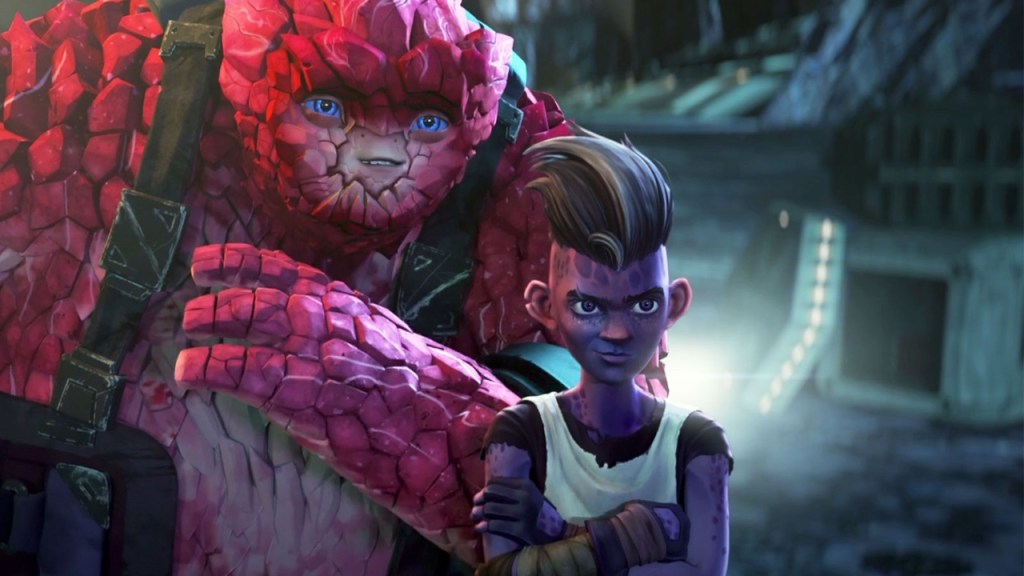
Lost and Found (PROD)
Season 1 Episodes 1 and 2
Honestly, any episode of Star Trek: Prodigy could make this list. What could be more optimistic than the story of enslaved children from the Delta Quadrant escaping via an abandoned Starfleet vessel and embracing Federation ideals? Heck, the show even managed to rehabilitate long-derided characters like Wesley Crusher and Chakotay (season three challenge: make Malcolm Reed likable). Since we can’t put the entire series on this list, we’ll just include the two-part premiere “Lost and Found.”
“Lost and Found” introduces the key figures in the story, including the brash Dal, the conflicted Gwyn, and the affable Tellarite Jankom Pog (voiced, of course, by Jason Mantzoukas). The kids all live on a planet controlled by the evil Diviner (John Noble, another perfect casting choice), but they find a way out via the USS Protostar, abandoned in the Delta Quadrant by a missing Chakotay. “Lost and Found” only sets the kids on the first steps of their journey, but they’re already brimming with hope—hope that will be tested and, by the time we reach the season two (and possibly series) finale, prove true.
